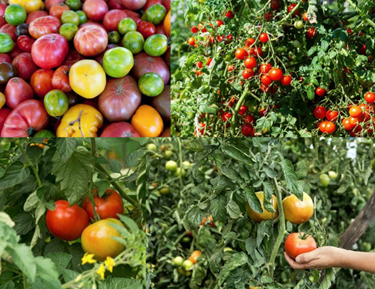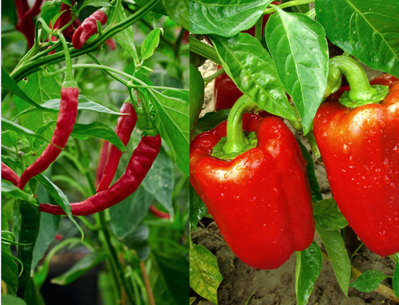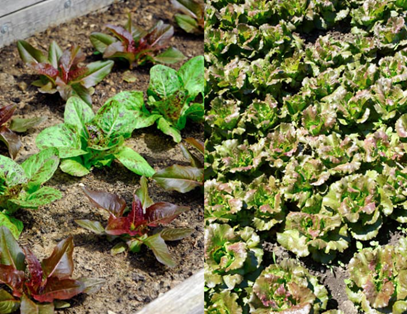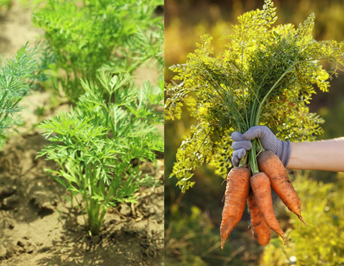…and how to grow them!
Guest Contributor: Cassey Anderson, Horticulture Agent, Colorado State University Extension

As we head into gardening season, many community-minded gardeners ask: What vegetables should I plant for donation?
Fresh Food Connect regularly polls their local hunger relief partners on what kinds of produce they could use most. The #1 answer is "All veggies are welcome!" But when considering factors like storage, shelf life, and ease of preparation, there are certain vegetables that are more versatile for donation. (Also, remember that tree fruits are also great for donation!)
Let's focus on the top 5: Tomatoes (no great surprise there!), Peppers, Onions, Lettuce, and Carrots. So, let’s get into some hints and tips for successfully growing these five crops.
#1 Most Requested : Tomatoes

I’ll keep this at the top of the list (and it will be the longest) because although at times tricky, tomatoes are a favorite of gardeners and aspiring gardeners everywhere. Like most vegetables, tomatoes prefer soil that is well drained and rich (i.e. that has organic material of about 5%). Tomatoes require full sun (6-8 or more hours) and require regular watering, but be cautious not to over water - you can let the soil dry between watering events.
Tomatoes will need to be started early (6-10 weeks before last frost) or purchased as small transplants. Wait to transplant until all risk of frost has ended and soil temperatures are above 55 F. Fertilize regularly but lightly at transplant, after 3 weeks and then as fruit begin to set.
When planting, remove all but the top 4-5 leaves and plant the tomato on its side into a shallow trench several inches deep. Tomatoes can produce new roots on stems that are planted below the surface. This will give your plant a robust root system. Tomatoes need at least 18-24” of space and will typically need some sort of support structure. The small tomato cages sold at nurseries will not always be sufficient. Supports should be put in place before the plants get large. You’re better off building one from concrete mesh or cattle panel fencing, or use a system like staking or stringing, or Florida weave. The internet abounds with ideas on supporting your tomatoes, but the important thing is to do it.
If you have days regularly above 85 F you may need to provide shade for your tomatoes to ensure good fruit set. Shade cloth can reduce the intensity of the sun and lower the ambient temperature. High temperatures will cause the plant to abort their flowers and then you won’t get fruit.
Harvest can happen any time after the fruit has begun to “pink” on the blossom end (unless you like fried green tomatoes, in which case go earlier!). The longer you allow the fruit to hang, generally, the better the flavor. However, it can be better for the large beefsteak varieties to harvest them a few days before fully ripe.
Tomatoes can be susceptible to many insects and diseases. Most insects can be managed in the growing season. Many tomato diseases will need to be managed by removal of the affected plant.
#2 Most Requested : Peppers

Peppers are related to tomatoes but don’t seem to have quite as many issues. Peppers are abundant in size and flavor. They can be spicy or sweet and any combination in between. They are also a warm season crop and so need to be started inside and transplanted or purchased as small seedlings. Most plants will require about 18” of space.
Transplant out once soil temperatures have warmed above 55 F and any risk of frost has passed. With any plant that has been grown inside it’s important to harden your seedlings off before planting them out. To do this, put your seedlings outside in a protected area for increasing intervals each day over about a week (1 hour on the first day, 2 on the second etc.) This will help them adjust from indoor climate to their outdoor reality.
Peppers will need regular fertilization at planting and at least two more times over the season. They require consistent water to grow well but be sure to let the soil dry in between irrigation. They can also benefit from shading in the heat of the summer. Shading can prevent scald issues that can occur on the growing and maturing fruit.
Peppers are susceptible to similar insects as tomatoes and, as with tomatoes, if they succumb to a disease the best management approach is to remove the plant.
Many peppers can be harvested either green or colored. It may take up to 3 weeks from mature size to reach mature color. It is always best to clip pepper fruit from the plant to avoid damaging the plant.
#3 Most Requested : Onions

Onions have a long growing season but can be simple so long as you water and feed them regularly. You can plant onions as seeds, sets, or transplants and all are perfectly fine. Seeds need to be started early in the year, as early as mid-March in some areas. Sets or starts can be planted later in the season around Mid-April to Mid-May. Space all with about 3” spacing to allow the onion bulbs to fully mature.
Be sure to find onions that are the correct type for your area. Onions grown in the Southern U.S. are grown in winter and so have been bred to grow during short days so are listed as “short day” types. Those of us in the Northern U.S. grow in the summer, so we want “long day” varieties.
Onions should be fertilized regularly with nitrogen, every 2-3 weeks with regular and abundant water to ensure rapid growth and sweeter flavors. Be on top of weeding during the growing season as onions have a poor root system that does not compete well with other plants or weeds.
Harvest can occur after about 1/3 of your onion stalks have fallen over, also known as lodging. Cure bulbs in a warm, dry area out of the sun. To harvest simply dig a shovel several inches under the soil surface. Be aware that different onion types have different longevity. Generally yellow onions can store longest, whereas whites and reds have a shorter storage period.
#4 Most Requested : Lettuce

Easy to grow and quick to harvest, lettuce can tolerate some shade. Lettuce does require regular watering to prevent bitter flavors or tip burn. More water can also produce a more tender leaf.
Planting can happen as soon as soil can be worked in spring and planting in succession ensures you have a small amount of harvest at regular intervals, so plant 1-2 rows every few weeks. Most lettuce will produce for a couple of months until summer heat brings on flowering, also known as bolting.
You can plant a second crop for a fall harvest in July or August.
Lettuce does need a rich soil and/or regular fertilization. Side dress your greens about every 3 weeks. If you’re growing lettuce into heads, you’ll need to thin your plants down to 6-12” spacing. The benefit of thinning is that you can eat your thinned plants!
Lettuce can be harvested in several ways. You can wait for the whole plant to mature and harvest the entire head; this is common for Romaine and Butterhead varieties. If you like to harvest and re-grow, you can harvest only the outer leaves or leaving at least 2” of leaf on the grown. Harvest all lettuce with a sharp knife or scissors rather than tearing.
There are so many varieties of lettuce to play around with so have fun with this quick and simple crop!
#5 Most Requested : Carrots

Sometimes challenging to get started but easy once they’re germinated. Carrots do not push through the crust on the soil surface well. You can water frequently during the 1-2 weeks of germination, cover with sand or light mulch, or with a cloth. Some gardeners will plant radishes with carrots. Once the radish push through it makes it easier for the carrots to germinate as well and the radishes are harvested long before the carrots so they don’t compete for space.
Carrots are a cool season crop, so you can plant them in spring and mid-summer for a second fall harvest. Carrots grow best in a light soil; they can struggle more in a clay soil. Carrots need regular and ample water, especially for gemination. Fertilize once or twice in the season.
You can mulch carrots to keep soils moist but wait until after seedlings have emerged. Once seedlings have emerged thin to the seed package recommendations (usually 1-2” spacing).
Carrot harvest can happen at any time in their development – you may pull one up every few weeks and check on their size. Carrots can be stored in ground if you mulch your garden beds in well over winter. For areas that freeze deeply this may not be possible. To harvest, loosen the soil near the roots with a garden fork or shovel and then pull the carrot at the ground level. Be sure to remove the carrot greens as soon as possible as they will impact the flavor of the root when stored.
As always, reach out to your local Extension office with additional questions and for further resources. Happy Gardening!
Gardening in Colorado? Check out Grow & Give www.growandgivecolorado.org and in particular our Colorado Vegetable Guide https://growgive.extension.colostate.edu/colorado-vegetable-guide/ for more crop information on all of the above plants.
Your garden can make a difference!
Donating your extra homegrown produce for hunger relief is a meaningful way to give back in your community. The free Fresh Food Connect mobile app connects you to a local hunger relief program, then manages and tracks your donations of homegrown produce throughout the season. 🍅Download the app to get started!🍅